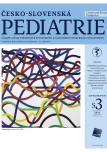Current perspectives on the aetiology of tall stature in children and adolescents (2): Non-syndromic tall stature
Authors:
Adamovičová Kateřina; Plachý Lukáš; Lebl Jan; Koloušková Stanislava; Průhová Štěpánka
Authors‘ workplace:
2. lékařská fakulta Univerzity
; Karlovy a Fakultní nemocnice, v Motole
; Pediatrická klinika
Published in:
Čes-slov Pediat 2022; 77 (Supplementum 3): 18-23.
Category:
Comprehensive Report
doi:
https://doi.org/10.55095/CSPediatrie2022/054
Overview
Non-syndromic tall stature can be caused by growth hormone overproduction, hyperthyroidism, obesity, hypogonadism, precocious puberty or as constitutional growth acceleration. There are conditions caused by a genetic cause as well such as non-sydromic tall stature, typically familial tall stature or, more rarely, pituitary gigantism, which includes X-linked acrogigantism (XLAG). Tall stature can rarely occur in neurofibromatosis type I or in glucocorticoid resistance. After excluding the common endocrinopathies the patients are, in clinical practice, assigned as “familial tall stature” or “constitutional growth acceleration”. Recently, there have been findings showing that non-syndromic tall stature can be caused by a monogenic cause, which can only be found by detailed genetic testing with precise clinical-genetic evaluation.
Keywords:
tall stature – growth hormone overproduction – FIPA – XLAG – familial tall stature
Sources
- Meazza C, Gertosio C, Giacchero R, et al. Tall stature: a difficult diagnosis? Ital J Pediatr 2017;43(1):66.
- Albuquerque E, Scalco RC, Jorge A. Management of endocrine disease: Diagnostic and therapeutic approach of tall stature. Eur J Endocrinol 2017; 176(6): 339–353.
- Leung AKC, Leung AAC, Hon KL. Tall stature in children. Adv Pediatr 2019; 66 : 161–176.
- Wei C, Gregory JW. Physiology of normal growth. Paediatrics Child Health 2009; 19(5): 236–240.
- Baron J, Sävendahl L, De Luca F, et al. Short and tall stature: a new paradigm emerges. Nat Rev Endocrinol 2015; 11(12): 735–746.
- Lazarus JE, Hegde A, Andrade AC, et al. Fibroblast growth factor expression in the postnatal growth plate. Bone 2007; 40(3): 577–586.
- Liu Z, Lavine KJ, Hung IH, Ornitz DM. FGF18 is required for early chondrocyte proliferation, hypertrophy and vascular invasion of the growth plate. Dev Biol 2007; 302(1): 80–91.
- Mancilla EE, De Luca F, Uyeda JA, et al. Effects of fibroblast growth factor-2 on longitudinal bone growth. Endocrinology 1998; 139(6): 2900–2904.
- Hung IH, Yu K, Lavine KJ, Ornitz DM. FGF9 regulates early hypertrophic chondrocyte differentiation and skeletal vascularization in the developing stylopod. Developmen Biol 2007; 307(2): 300–313.
- Nilsson O, Parker EA, Hegde A, et al. Gradients in bone morphogenetic protein–related gene expression across the growth plate. J Endocrinol 2007; 193(1): 75–84.
- De Luca F, Barnes KM, Uyeda JA, et al. Regulation of growth plate chondrogenesis by bone morphogenetic protein-2. Endocrinology 2001; 142(1): 430–436.
- Hannema SE, van Duyvenvoorde HA, Premsler T, et al. An activating mutation in the kinase homology domain of the natriuretic peptide receptor-2 causes extremely tall stature without skeletal deformities. J Clin Endocrinol Metab 2013; 98(12): 1988–1998.
- Miura K, Kim OH, Lee HR, et al. Overgrowth syndrome associated with a gain–of–function mutation of the natriuretic peptide receptor 2 (NPR2) gene. Am J Med Genet A 2014; 164 A (1): 156–163.
- Chan Y, Holmen OL, Dauber A, et al. Common variants show predicted polygenic effects on height in the tails of the distribution, except in extremely short individuals. PLoS Genet 2011; 7(12): e1002439.
- Plachy L, Dusatkova P, Maratova K, et al. Familial short stature—a novel phenotype of growth plate collagenopathies. J Clin Endocrinol Metabolism 2021; 106(6): 1742–1749.
- Corredor B, Dattani M, Gertosio C, Bozzola M. Tall stature: a challenge for clinicians. Curr Pediatr Rev 2019; 15(1): 10–21.
- Vasilev V, Daly AF, Trivellin G, et al. Hereditary endocrine tumours: current state-of-the-art and research opportunities: The role of AIP and GPR101 in familial isolated pituitary adenomas (FIPA ). Endocr Rel Cancer 2020; 27(8): T77–T86.
- Beckers A, Petrossians P, Hanson J, Daly AF. The causes and consequences of pituitary gigantism. Nat Rev Endocrinol 2018; 14(12): 705–720.
- Cannavo S, Ragonese M, Puglisi S, et al. Acromegaly is more severe in patients with AHR or AIP gene variants living in highly polluted areas. J Clin Endocrinol Metab 2016; 101(4): 1872–1879.
- Daly AF, Lysy PA , Desfilles C, et al. GHRH excess and blockade in X–LAG syndrome. Endocr Rel Cancer 2016; 23(3): 161–170.
- Beckers A, Lodish MB, Trivellin G, et al. X-linked acrogigantism syndrome: clinical profile and therapeutic responses. Endocr Rel Cancer 2015; 22(3): 353–367.
- Pagani S, Radetti G, Meazza C, Bozzola M. Analysis of growth hormone receptor gene expression in tall and short stature children. J Pediatr Endocrinol Metab 2017; 30(4): 427–430.
- Carmi D, Shohat M, Metzker A, Dickerman Z. Growth, puberty, and endocrine functions in patients with sporadic or familial neurofibromatosis type 1: a longitudinal study. Pediatrics 1999; 103(6): 1257–1262.
- Meimaridou E, Hughes CR, Kowalczyk J, et al. Familial glucocorticoid deficiency: New genes and mechanisms. Mol Cell Endocrinol. 2013; 371(1–2): 195–200.
- Savage MO, Lebrethon MC, Blair JC, et al. Growth abnormalities associated with adrenal disorders and their management. Horm Res 2001; 56 Suppl 1 : 19–23.
Labels
Neonatology Paediatrics General practitioner for children and adolescentsArticle was published in
Czech-Slovak Pediatrics

2022 Issue Supplementum 3
Most read in this issue
- Minipuberty – an important and still neglected period of sexual development
- First experience with long-acting growth hormone
- Current perspectives on the aetiology of tall stature in children and adolescents (1): Syndromes associated with tall stature
- Children and adolescents with gender incongruence: current approaches and situation in the Czech Republic
